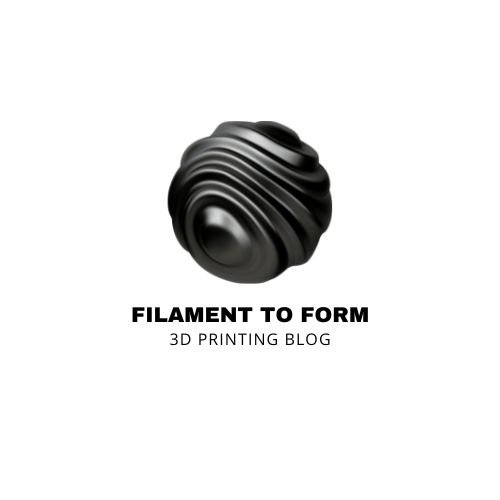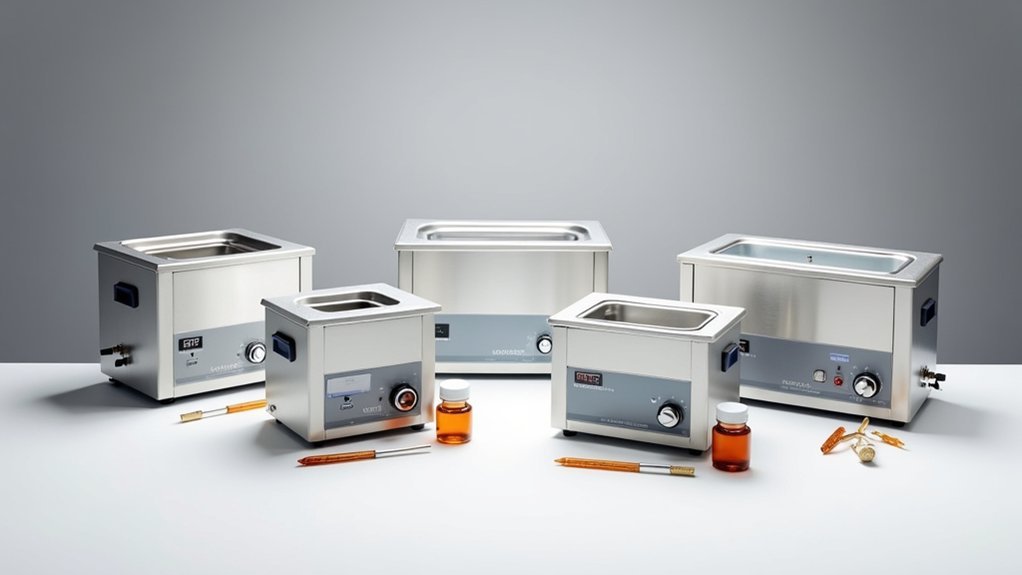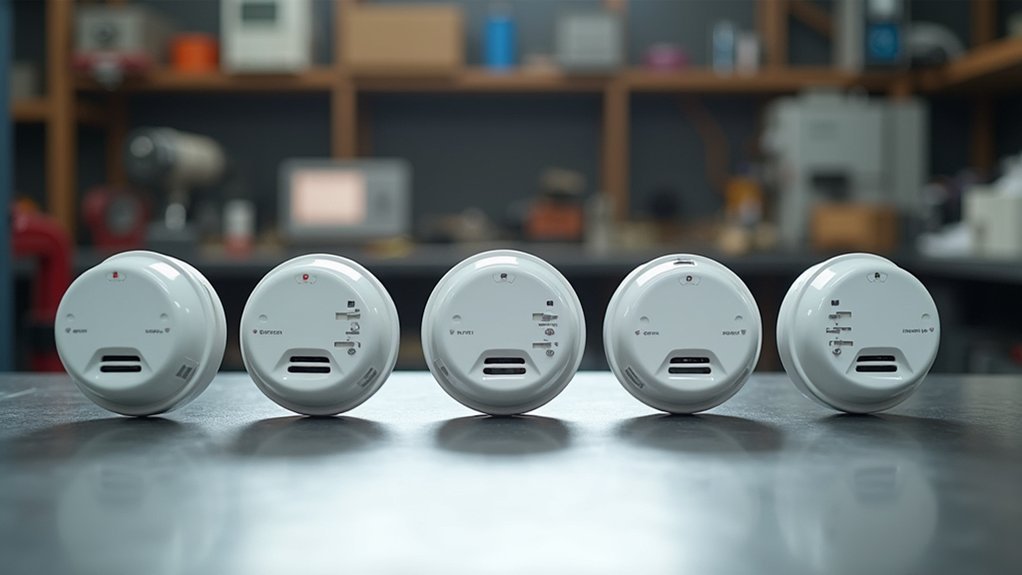You’ve spent hours perfecting your resin prints, but now you’re facing the messy reality of post-processing cleanup. The right ultrasonic cleaner can transform this tedious task into a quick, efficient process that removes uncured resin without damaging your detailed work. However, not all ultrasonic cleaners handle resin effectively, and choosing the wrong one could leave you with poor results or even damaged prints that force you back to square one.
VisiClean Ultrasonic Jewelry Cleaning Machine
If you’re seeking an affordable entry point into ultrasonic cleaning for your resin prints, the VisiClean Ultrasonic Jewelry Cleaning Machine offers solid performance at 65 watts in a compact 8.7 x 5.4 x 5.6-inch footprint. You’ll find multiple time settings for varying cleaning intensity, though it works best for light cleaning rather than heavily soiled prints. The device features user-friendly design elements like a handle on the cover. However, you should be aware of potential overheating concerns during extended operation. It operates on 110V only, so international users need transformers. Customer service provides responsive support with refund options for defective units.
Best For: Budget-conscious users who need an affordable ultrasonic cleaner for light cleaning tasks on jewelry, eyeglasses, dental appliances, and lightly soiled resin prints.
Pros:
- Compact and user-friendly design with convenient features like a handle on the cover
- Multiple time settings allow for customizable cleaning intensity based on different items
- Responsive customer service with refund options for defective units
Cons:
- Limited to light cleaning tasks and less effective on heavily soiled items
- Potential overheating issues during extended operation periods
- 110V-only operation requires transformers for international use outside the USA
LifeBasis Ultrasonic Jewelry Cleaner, 20 Ounces with Digital Timer
The LifeBasis Ultrasonic Jewelry Cleaner stands out as an excellent entry-level option for hobbyist 3D printer users who need reliable resin cleanup without breaking the bank. You’ll appreciate its 20-ounce capacity and precise 42,000-45,000 Hz frequency range that effectively removes uncured resin from detailed prints. The digital timer offers five preset cycles from 90 to 600 seconds, letting you customize cleaning duration based on your print complexity. Its SUS 304 stainless steel tank resists corrosion from cleaning solvents, while the built-in cooling fan prevents overheating during extended use. You’ll find it compact enough for any workspace.
Best For: Hobbyist jewelry makers, eyeglass wearers, and watch collectors who need gentle yet effective cleaning for delicate items at home.
Pros:
- Operates at optimal 42,000-45,000 Hz frequency with 35W power for thorough cleaning without damaging delicate items
- Features digital timer with 5 preset cycles (90-600 seconds) and auto shut-off for convenient, customizable operation
- Built with durable SUS 304 stainless steel tank and cooling fan for corrosion resistance and extended lifespan
Cons:
- Some users report issues with button sealing that may affect long-term durability
- Light-duty performance may require multiple cycles for heavily soiled items or thorough cleaning
- Limited to smaller items due to 20-ounce capacity, making it unsuitable for larger objects
Ultrasonic Jewelry Cleaner, 48KHz Cleaner for Jewelry & Eyeglasses
Budget-conscious makers seeking dual-purpose cleaning equipment will find exceptional value in this 48KHz ultrasonic jewelry cleaner that doubles as an effective resin print cleanup solution. You’ll get dual cleaning modes—5 minutes for standard cleanup and 7 minutes for heavily soiled prints. The 12oz SUS 304 stainless steel tank offers excellent corrosion resistance when using cleaning solvents. You can clean multiple small prints simultaneously, though you’ll need 15-minute breaks between cycles due to heat buildup. The compact design won’t dominate your workspace, and quiet operation won’t disturb others during extended cleaning sessions.
Best For: Budget-conscious makers and hobbyists who need versatile cleaning equipment for both jewelry/eyeglasses and resin 3D prints, offering dual-purpose functionality in a compact workspace-friendly design.
Pros:
- Dual cleaning modes (5 and 7 minutes) with 48KHz frequency effectively removes dirt and grime from delicate items without damage
- Versatile 12oz stainless steel tank accommodates multiple items simultaneously and resists corrosion from various cleaning solvents
- Compact, quiet design fits easily on countertops without dominating workspace or disturbing others during operation
Cons:
- Requires 15-minute cooling periods between cycles due to significant heat buildup during operation
- Mixed user feedback on noise levels, with some finding it louder than expected despite being marketed as quiet
- Limited 12oz capacity may require multiple cleaning cycles for larger batches of items
AI Ultrasonic Jewelry Cleaner, 50KHz Professional Cleaner Machine with 304 Stainless Steel
Advanced 50KHz dual-frequency technology makes the AI Ultrasonic Jewelry Cleaner an exceptional choice for resin printing enthusiasts who demand professional-grade cleaning performance. You’ll appreciate the 304-grade stainless steel construction that resists corrosion from cleaning solvents and provides industrial-standard durability. The dual-frequency system creates powerful microbubble cavitation that efficiently removes uncured resin from your printed models while remaining gentle on delicate surfaces. Its leak-proof seamless tank prevents solvent seepage, extending service life considerably. The 12-ounce capacity handles most print batches, and you’ll find the quiet operation and dual timer modes enhance your workflow in any workspace environment.
Best For: Resin printing enthusiasts and professionals who need reliable, industrial-grade ultrasonic cleaning for removing uncured resin from printed models and maintaining equipment.
Pros:
- Dual-frequency 50KHz technology with microbubble cavitation provides powerful yet gentle cleaning for delicate printed models
- Premium 304-grade stainless steel construction resists corrosion from cleaning solvents and offers industrial durability
- Leak-proof seamless tank design prevents solvent seepage and extends service life with quiet operation
Cons:
- 12-ounce capacity may be limiting for larger print batches or bigger models
- Requires specialized ultrasonic cleaning fluid for optimal results, adding to ongoing costs
- Price point may be higher than basic cleaners for hobbyists with occasional cleaning needs
VEVOR Professional Ultrasonic Cleaner with Digital Timer & Heater (3L)
When you need serious cleaning power without breaking the bank, VEVOR’s Professional Ultrasonic Cleaner delivers 120W of ultrasonic energy through advanced sandwich piezoelectric transducers that’ll strip stubborn resin from your prints effectively. The 3L 304 stainless steel tank operates at 40kHz with digital controls for 0-30 minute timing and 0-80℃ heating. You’ll appreciate the 100W heater that enhances cleaning efficiency for tough residue removal.
While it’s noisier during heating cycles, users report excellent results cleaning various items including mechanical parts. The non-removable tray complicates maintenance, but this FCC/CE certified unit offers solid value for resin print cleanup when paired with appropriate cleaning solutions.
Best For: Hobbyists and professionals who need a cost-effective ultrasonic cleaner for resin 3D prints, jewelry, eyeglasses, and mechanical parts with the power to handle stubborn residue.
Pros:
- Powerful 120W ultrasonic cleaning with advanced piezoelectric transducers and 100W heating for effective residue removal
- Digital controls with precise timing (0-30 minutes) and temperature settings (0-80℃) for customized cleaning cycles
- High-quality 304 stainless steel construction with FCC/CE certification at an affordable price point
Cons:
- Noisy operation, especially during heating cycles, which may be disruptive in quiet environments
- Non-removable cleaning tray makes thorough maintenance and cleaning difficult
- Some reliability issues reported with units shutting off after extended use
Factors to Consider When Choosing Ultrasonic Cleaners for Resin Print Cleanup
When you’re selecting an ultrasonic cleaner for resin print cleanup, you’ll need to evaluate several critical specifications that directly impact cleaning performance. Tank size must accommodate your largest prints, while ultrasonic frequency affects cleaning intensity and the types of contaminants removed. You should also consider temperature control capabilities, chemical compatibility with your cleaning solvents, and power output levels that match your specific resin removal requirements.
Tank Size Requirements
Three key dimensions determine whether an ultrasonic cleaner will handle your resin printing needs effectively. You’ll want a minimum tank capacity of 1 liter for standard-sized prints, though larger pieces require 3 liters or more. Don’t just focus on volume—consider the tank’s length, width, and depth to accommodate your specific print shapes and sizes.
A deeper tank enhances cleaning efficiency by allowing ultrasonic waves to penetrate around your entire piece, reaching intricate details more effectively. You’ll need enough cleaning solution to completely submerge your prints, typically requiring 1.5 to 2 times the print’s height for ideal results. Factor in whether you’ll clean single large prints or multiple smaller items simultaneously when selecting your tank size.
Ultrasonic Frequency Selection
Since frequency directly impacts cleaning effectiveness and print safety, you’ll need to select the right ultrasonic range for your resin cleanup needs. Most ultrasonic cleaners operate between 20 kHz and 80 kHz, but you’ll want to focus on the 40-48 kHz range for ideal resin print cleaning. This frequency range balances effective cavitation with minimal surface damage to your delicate prints.
Avoid frequencies below 40 kHz, as they create larger bubbles that can cause surface imperfections on fragile resin models. For prints with intricate details, consider frequencies above 50 kHz, which generate smaller bubbles that penetrate tight crevices more effectively. Remember to match your chosen frequency with compatible cleaning solutions, as certain solvents perform better at specific ultrasonic ranges.
Temperature Control Features
Temperature control features greatly improve your cleaning results by enhancing solvent effectiveness and reducing cleaning times. Many ultrasonic cleaners offer adjustable heating settings from ambient to 80°C (176°F), allowing you to select ideal temperatures for stubborn resin removal. Higher temperatures increase solubility, making residues easier to dissolve and remove from your prints.
Advanced models include built-in heating elements that maintain stable temperatures throughout the entire cleaning cycle, delivering more consistent results. This temperature consistency prevents overheating of delicate components while preserving the integrity of sensitive items. You’ll find that proper temperature management creates a safer cleaning environment and considerably reduces the time needed for effective resin cleanup, making your post-processing workflow more efficient overall.
Chemical Compatibility Considerations
When selecting cleaning solvents for your ultrasonic cleaner, you must verify that both the tank material and chemical formulations work together safely. Stainless steel tanks offer excellent compatibility with most resin cleaning solvents, preventing corrosion and damage that can occur with inferior materials.
You’ll want to choose cleaning solutions that won’t degrade your resin prints or react negatively with plastic components. Some solvents can cause adverse chemical reactions, compromising both your prints and equipment.
Pay attention to heat generation during operation, as elevated temperatures can alter your cleaning solution’s properties and affect resin characteristics. Always consult manufacturer guidelines for both your ultrasonic cleaner and resin materials to guarantee proper compatibility and prevent unexpected reactions that could damage your equipment or prints.
Power Output Specifications
While chemical compatibility guarantees your equipment remains undamaged, you’ll need adequate power output to achieve effective resin removal from your prints. Look for ultrasonic cleaners with 65W to 120W power output for efficient cleaning capabilities. Higher wattage generally means better performance, but you’ll want to balance this with frequency ranges between 40kHz to 48kHz for ideal results.
Choose models featuring multiple transducers that distribute energy evenly throughout the cleaning solution, ensuring thorough resin removal from all print surfaces. Adjustable power settings give you control over cleaning intensity, allowing you to customize the process based on your print’s fragility and resin residue levels. This combination of appropriate power and frequency considerably reduces cleaning time while protecting delicate print details.
Build Quality Materials
The foundation of any reliable ultrasonic cleaner starts with its construction materials, which directly impact both performance and longevity. You’ll want to prioritize models crafted from 304-grade stainless steel, as this material offers superior durability and corrosion resistance against harsh cleaning solvents used in resin print cleanup. This construction greatly extends your device’s lifespan while maintaining consistent performance.
Look for leak-proof designs that prevent fluid seepage and protect internal components from damage. This feature’s vital when working with cleaning solutions that could compromise electronic parts. You should also evaluate the ultrasonic transducer technology, since advanced designs enhance cleaning efficiency without damaging delicate printed parts. Consider the unit’s weight and dimensions too—compact, lightweight models offer easier storage and handling for regular maintenance tasks.
Frequently Asked Questions
How Long Should I Run the Ultrasonic Cleaner for Resin Prints?
You’ll typically run your ultrasonic cleaner for 3-5 minutes for the first cleaning cycle. If there’s stubborn resin residue remaining, you can run a second 2-3 minute cycle for thorough removal.
What Cleaning Solution Works Best With Ultrasonic Cleaners for Resin Removal?
You’ll get best results using 99% isopropyl alcohol for resin removal. It’s most effective at dissolving uncured resin. Alternatively, you can use specialized resin cleaning solutions, but IPA remains the gold standard for ultrasonic cleaning.
Can Ultrasonic Cleaners Damage Delicate Resin Print Details or Thin Walls?
You can damage delicate details if you’re too aggressive. Use lower frequency settings, shorter cleaning cycles, and gentler solutions. Support thin walls properly and avoid excessive cavitation that’ll erode fine features.
Do I Need to Pre-Rinse Resin Prints Before Ultrasonic Cleaning?
You don’t need to pre-rinse resin prints before ultrasonic cleaning. However, removing excess uncured resin first will keep your cleaning solution cleaner longer and improve overall cleaning effectiveness.
What’s the Difference Between Using IPA Versus Water-Based Solutions in Cleaners?
IPA dissolves uncured resin more effectively than water-based solutions, giving you faster, thorough cleaning. However, water-based cleaners are safer, less flammable, and won’t damage your ultrasonic cleaner’s seals over time.





Leave a Reply